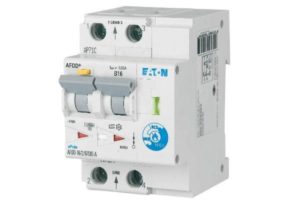 John Robb, Segment Leader Commercial Buildings EMEA, Eaton considers the threat of arc fault incidents to commercial buildings and the methods of protection that can be implemented to reduce the risk.
John Robb, Segment Leader Commercial Buildings EMEA, Eaton considers the threat of arc fault incidents to commercial buildings and the methods of protection that can be implemented to reduce the risk.
Arc fault is a silent – and often overlooked – threat to every commercial building in the UK. These instances of electric micro lightning can develop quietly over time, creating a hidden set of conditions that escalate without any obvious sign of danger. Yet they are one of the main causes of electrically ignited fires – and a big risk for unknowing UK businesses.
Non-residential buildings are common places for electrical fires caused by an arc fault. These can range from retail spaces and industrial buildings to hospitals, stadiums, airports and restaurants. Arc faults can be caused by a number of factors: faulty appliances, bent wires or plugs, wires crushed by furniture, broken cables, loose connections or contacts, exposure to rodent bites or UV rays. On a smaller scale, electrical arcs may also be due to the simple ageing of an installation or the pressure placed upon installation cables by increased usage.
The arc fault threat
No matter the cause, arc faults always carry a hefty risk of fire. In fact, the UK-based National Fire Protection Association (NFPA) has stated that arc faults outnumber overheating by at least two-to-one and possibly as much as seven-to-one when looking at the causes of electrically ignited fires in the home.
While traditional circuit breakers are often thought to provide full protection – as they are designed to prevent electrocution and protect equipment by detecting earth fault currents, short-circuits and over-current hazards – this is not the case. As a result, a lack of awareness is one of the biggest issues surrounding arc faults.
The personal and financial impact
Fire has the potential to put hundreds of occupants at risk within a matter of seconds. And when it comes to protecting life and property, there’s no room for compromise.
According to UK fire statistics published by the Home Office, there were 15,984 fires in non-domestic buildings from 2015-2016, including industrial premises, offices, healthcare facilities, leisure venues and hotels. These led to 21 deaths and 1,089 casualties requiring hospital treatment – a slight increase on 2014-2015.
The potential consequences of failing to plan properly are difficult to overestimate. However, it’s clear that those charged with managing commercial buildings must place greater importance on safeguarding electrical installations to mitigate the risk of fire and ensure the safety of those inside the building.
Beyond the risk to safety and life, fires can also have a major financial impact. Factoring in costs for both repairing damage after a fire and insurance payments can lead to huge figures. In 2012, the cost of commercial fire damage in the UK was circa £620m – equating to £1.7 million every single day. When you consider the wider impact a fire can have on the bottom line – from lost orders and contracts to key employees moving to a different organisation – the potential financial consequences can be severe.
Protecting against arc faults
Arc fault detection devices (AFDD) provide the best defence against electrically ignited fires. These work by digitally monitoring the wire for specific frequencies that can indicate an arc fault. They can be installed alongside traditional circuit devices like miniature circuit breakers (MCBs), which use thermal and magnetic detection to identify short circuit and over-current hazards, as well as residual current devices (RCDs), which use a balance transformer to detect earth faults. Technological advances have now enabled power management companies to introduce new versions that combine all three devices, offering facilities managers and business owners even greater protection and peace of mind.
Powering commercial buildings is reliant upon the low-voltage distribution panels at the heart of buildings’ electrical infrastructure. And these panels face huge demands – particularly as operations and infrastructure expand over time. Yet, despite the prevalent risk of electrically ignited fires, AFDDs are not yet mandatory throughout Europe. Instead, the international standard IEC 60364 (Part 4-42) only recommends AFDDs, leaving each country to decide for themselves, with potential recommendations for the UK being offered by this summer’s release of the IET Wiring Regulations Eighteenth Edition.
Deciding to implement preventative measures
In countries where the use of AFDDs is not compulsory, the installation of such devices relies on building managers, installers and electricians. This is particularly key for commercial buildings where large groups of people gather and a fire could quickly impact considerable numbers of employees, shoppers, sports fans or whoever may be in the building. In these instances, the installation of arc fault detection devices can give the installer, specifier/consultant and property owner greater peace of mind.
Installers and electricians, in particular, have a responsibility to look beyond the minimum industry requirements. They should utilise and share new methods and information that ultimately support the best approach for the highest levels of safety.
With demand for electrical power on the rise, arc fault protection must shift from a “luxury” to a must. Strategic fire prevention policies must include technology like AFDDs to keep fire at bay – and those in the building safe.
Source: https://www.voltimum.co.uk/articles/invisible-hazard-threat-arc-fault




